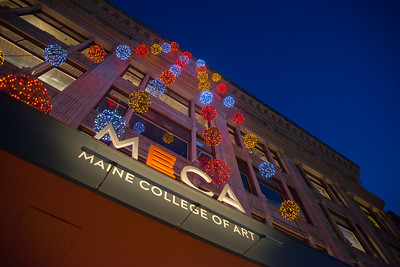I read an interesting article this morning in the Portland Press Herald about the Maine College of Art and Design. The school is innovating its way to a resurgence, following years of declining enrollment.
Formerly known as MECA, the 140-year-old school has repurposed an old Porteous, Mitchell and Braun department store building. Porteous, Mitchell and Braun was the last department store to leave downtown Portland in the early 1990’s. But the Renaissance Revival building, built in 1904, fit the MECA (now MECA&D) vibe. The school transformed the multistory retail space into vast classrooms and studios.
MECA&D is the oldest independent art school in the State of Maine. Originally opened in 1882, the school currently enrolls about 500 undergraduate and graduate students. About one-third of MECA&D students come from the Maine. MECA&D’s enrollment is actually rising, but that’s a fairly new development. A decade ago, MECA was limping along with about 330 students.
The administration had a full-blown crisis on its hands. If they could not increase enrollment, MECA would need to close its doors. Closure is a real and growing issue among the nation’s higher education institutions. According to data provided by the US Department of Education, in the past 5 years, higher education institutions have permanently closed 3,042 campuses. 167 campuses closed in 2021 alone.
Innovating off of the demographic cliff
So, after a lot of institutional soul-searching, the MECA administration began innovating and drafted a plan to save the school. It started by adding &D to its name. Instead of focusing on what students could major in, the school highlighted what its alumni do following graduation. It revamped its educational programs to focus on the design element of its creative programs. Most of its students now major in a design program instead of the school’s more traditional craft programs. It also added a film program, and minors in music and entrepreneurship.
Additionally, MECA&D opened its building to its students 24 hours a day, 7 days a week. That move acknowledged that the students’ creative processes don’t always run according to MECA&D’s instructional hours. So far, the changes have been well received. MECA&D’s fall enrollment increased by 15%. That’s impressive, considering that overall enrollment in post-secondary programs has dwindled. The school administration acknowledges that there are fewer college-age students to go around, but MECA&D isn’t giving up.
The Press-Herald quoted MECA&D’s Vice President of Student Affairs, Ian Anderson, as saying “You have to innovate your way off this demographic cliff.”
“You have to innovate your way off this demographic cliff.”
Note that MECA&D isn’t trying to open retail space on its ground floor, or run a car dealership, or embark on some equally irrelevant business venture. The school is reinventing itself within the scope of its mission.
Innovating will determine which campuses survive and which don’t. Innovation doesn’t just appear. It comes from creative leaders with a passion for their institutions’ mission and real ideas. It doesn’t come from tired attempts to replicate something from somewhere else at some other time. And it doesn’t come from hijacking community resources in order to serve the political and financial desires of the few.
Photo Credit: Corey Templeton , via Flickr












